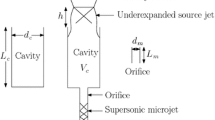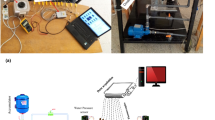Abstract
The powered resonance tube (PRT) actuator and its variants are new developments in active flow control (AFC) technology. The PRT is attractive because it has no moving parts and can produce acoustic tones that have amplitudes greater than 150 dB over a large frequency bandwidth. The first part of this paper deals with the resonance characteristics of the PRT as a function of the operating parameters such as jet-to-tube spacing (Sp), tube depth (d), and nozzle pressure ratio (NPR). It was found that: (1) at low NPR (3.33), the PRT resonates at discrete combinations of spacing and depth. (2) Using theoretical estimates for predicting shock cell lengths, one could observe a correlation between the theoretical prediction for shock cell length and the spacing at which the PRT resonates. (3) At high NPR (4.29), for a fixed depth, the PRT resonates at virtually all spacings. (4) The frequency at which the PRT resonates remains approximately constant, regardless of spacing. The second part of the study focused on examining the directivity of the acoustic radiation from the PRT—significant for developing orientation strategies of the PRT with respect to the target flow in the end application. The directivity of the fundamental PRT tone and that of its harmonics were studied for a variety of resonance frequencies, both separately as well as cumulatively. It was found that the fundamental part of the actuation signal radiated predominantly in the downstream direction of the jet for low resonance frequencies. As the resonance frequency was increased from 3 to 12 kHz, the directivity changed from downstream of the jet to vertically upward, and finally upstream of the jet at the higher frequencies.












Similar content being viewed by others
Notes
It is to be noted that the actual tonal frequency might be off from the quarter wavelength prediction; especially at shallow depths and high NPR, i.e., NPR above 4. At shallow depths, it is the acoustic coupling between the mass of the fluid within the resonance tube and the integration slot (Kerschen 2001); whereas at high NPR, it is the screeching and non-linear effects which are responsible for this deviation (Kerschen et al. 2004).
Abbreviations
- D :
-
Diameter of jet=6.35 mm (0.25 inch)
- d :
-
Resonator tube depth
- f :
-
Fundamental frequency
- λ:
-
Wavelength of the actuator signal
- M :
-
Fully expanded Mach no. based on the plenum pressure
- n :
-
Number of harmonics (e.g., n=2 represents the first harmonic)
- P RMS :
-
RMS value of the pressure
- Sp:
-
Spacing between the PRT nozzle and the resonator tube/integration slot width
- L shock :
-
Shock cell length
- X shock 1 :
-
Shock cell termination distance corresponding to the first shock
- X shock 2 :
-
Shock cell termination distance corresponding to the second shock
- X shock 3 :
-
Shock cell termination distance corresponding to the third shock
References
Brocher E, Maresca C, Bournay M (1970) Fluid dynamics of the resonant tube. J Fluid Mech 43:369–384
Cain AB, Kerschen E, Tassy J, Raman G (2004) Simulation of powered resonance tubes: Helmholtz resonator geometries. AIAA 2004–2690
Hartmann J, Troll B (1922) On a new method on the generation of the sound waves. Phys Rev 20:719–727
Kastner J, Samimy M (2002) Development and characterization of Hartmann tube based fluidic actuators for high speed flow control. AIAA Paper 2002–0128
Kastner J, Hileman J, Samimy M (2004) Exploring high-speed axisymmetric jet noise Control Using Hartmann Tube Fluidic Actuators. AIAA 2004–0186
Kerschen EJ (2001) Analytical modeling of the resonant frequencies of a powered resonance tube. Division of Fluid Dynamics of the American Physical Society Meeting, Nov. 18–20, 2001, San Diego, CA
Kerschen EJ, Cain AB, Raman G (2004) Analytical modeling of Helmholtz resonator based powered resonance tubes. Flow Control meeting, AIAA 2004–2691
Khanafseh S (2002) High bandwidth powered resonance tube actuators with feedback control. MS Thesis, Illinois Institute of Technology
Murugappan S, Gutmark E (2002) Parametric study of Hartmann-Sprenger tube. AIAA 2002–1012
Murugappan S, Gutmark E (2003) Experimental and computational study of high frequency actuation of supersonic jets. AIAA 2003–370
Raman G, Cain AB (2002) Innovative actuators for flow and noise control. Proc Inst Mech Eng Part G J Aerospace Eng 216:303–324
Raman G, Kibens V (2001) Active flow control using integrated powered resonance tube actuator. AIAA Paper 2001–3024
Raman G, Khanafseh S, Cain AB, Kerschen EJ (2004a) Development of high bandwidth powered resonance tube actuators with feedback control. J Sound Vib 269:1031–1062
Raman G, Mills A, Kibens V (2004b) Development of powered resonance-tube actuators for aircraft flow control applications. J Aircraft 41:1306–1314
Sarohia V, Lloyd HB (1979) Experimental investigation of flow and heating in a resonance tube. J Fluid Mech 94:649–672
Sarpotdar S, Raman G, Sharma SD, Cain A (2005) Impingement tone suppression using powered resonance tubes. AIAA 2005–0797
Savoy LE (1950) Experiments with the Hartmann acoustic generator. Engineering 170:99–100, 136–138
Smith TJB, Powell A (1964) Experiments concerning the Hartmann whistle. UCLA Report 64–41
Tam CKW (1995) Jet noise generated by large-scale coherent motion. In: Hubbard HH (eds) Aeroacoustics of flight vehicles, theory and practice, vol I. Acoustical Society of America, Melville
Acknowledgements
This work has been carried out under the support of AFOSR STTR Phase II Contract Number F49620-02-C-0098; Dr. John Schmisseur served as the AFOSR Program Manager.
Author information
Authors and Affiliations
Corresponding author
Rights and permissions
About this article
Cite this article
Sarpotdar, S., Raman, G. & Cain, A.B. Powered resonance tubes: resonance characteristics and actuation signal directivity. Exp Fluids 39, 1084–1095 (2005). https://doi.org/10.1007/s00348-005-0041-5
Received:
Revised:
Accepted:
Published:
Issue Date:
DOI: https://doi.org/10.1007/s00348-005-0041-5




